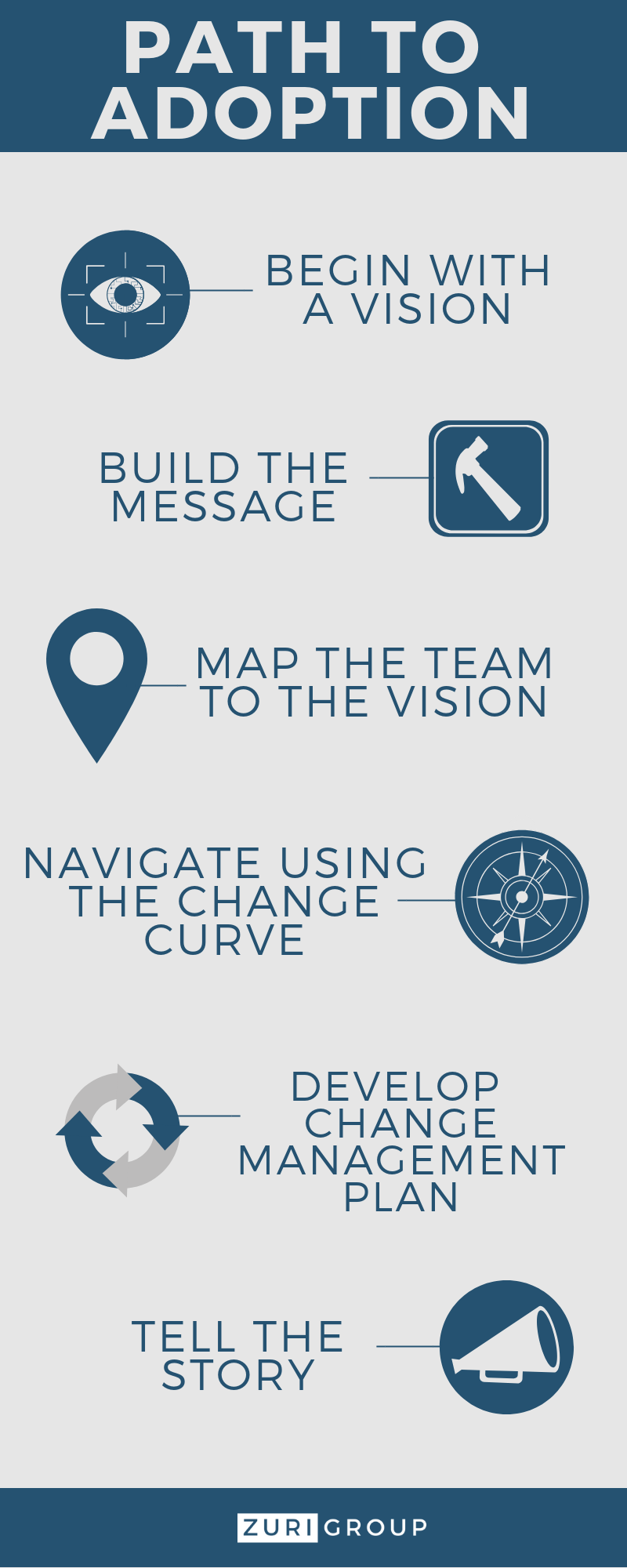“Never doubt that a small group of thoughtful, committed, citizens can change the world. Indeed, it is the only thing that ever has.” – Margaret Mead
Nonprofit technology is an ever-moving target. With new tools, more sophisticated intelligence, and better processes emerging all the time, it’s difficult for an organization to decide to make a change–especially one that has the potential to disrupt the current fundraising momentum. Even more difficult is enduring the fallout from that disruption–during implementation or after–which has a direct impact on adoption.
Given that we will always have organizational teams comprised of different levels of adaptability, we must design a change methodology that addresses each level of acceptance–from those who are excited by the new process, to those who are averse (or denying the inevitable). Believe it or not, you can even get the most embedded veteran staffers to change their minds about a new process or tool!
So how do you get everyone to align and move with you toward your vision of change? The goal is to change their perspectives on the solution. Communication strategy, information transparency, message delivery and level of excitement are all factors which impact whether someone feels informed and included or neglected and victimized.
 Begin with the Vision: You (or your leadership) has the vision for a new process or system, a vision based on capabilities that will be available in the future. The benefit of upgrading, implementing, or re-engineering is forthcoming.
Begin with the Vision: You (or your leadership) has the vision for a new process or system, a vision based on capabilities that will be available in the future. The benefit of upgrading, implementing, or re-engineering is forthcoming.
Build the Message: Build the project’s message around the vision. It should reflect a journey, or tell a story, about how we are all going to get to the benefits, and how those benefits will feel or impact our success.
Map the Team to the Vision: Be sure to include (this is very important!) where everyone will fit with the organization after the change is in place. Many process or system implementations include a shift in responsibility. It is important to review your staff talent, and align them with possible new responsibilities for your vision. Change made without consideration for the people involved will never see smooth success.
Navigate Using the Change Curve: Identifying individuals or small groups of like-minded staff and anticipating their response to the change ahead of time will help you understand how to communicate with them, how often to approach them, and how to guide them through the change. Believe it or not, folks who are already past acceptance and ready NOW are as difficult to communicate with as folks who are resistant. The key is to balance the communication so that the entire organization moves toward acceptance without too much distraction from overly-excited or frustrated individuals.
Develop a Change Management Plan: When working with nonprofit organizations, I like to use a set of stakeholder questions to understand individual perspectives and develop a solid change management plan. Starting with the core project team, I conduct a role-play activity to “put ourselves in their shoes” and try to see the change from different perspectives. Questions like “What motivates this person?” or “What is this team’s biggest concern?” will help guide thinking to craft appropriate messaging that will answer unnerving questions before they arise. Questions like “Will this individual’s job role change?” and “Does this person need to adopt the change or merely understand the change is happening?” will tailor the specificity of the details provided and the frequency of communication, so that we don’t overwhelm or under-inform.
Tell the Story – Once the change management plan is in place, use it to generate the overall messaging. The key is to provide a consistent, relevant story that reflects the vision, champions the impact, and overcomes objections and fears that the team may have about the project and the change it represents. Create a plan to engage smaller groups of people and craft “elevator pitches” for the team to use when encountering coworkers in the hallway. Be prepared to tell (and retell) the story in presentations, casual conversations, written emails or newsletters. And don’t forget to integrate the story into training materials, where the efforts of your consistency and planning are realized.
Building a path to adoption is often overlooked as unnecessary overhead for a project, especially when it is assumed that the impact will be minimal or the organization is ready and wanting a change. Those things may be true, but it is important to recognize that each individual moves toward adoption differently. Addressing individuality and the impact felt by the staff doing the work will prove to be an investment that supports a successful transition in the end – I promise.
 Kate is a Senior Consultant here at Zuri Group. With more than 15 years of experience in strategic, organizational, and fundraising systems consulting, Kate support client partners through strategy and change and provides the expertise needed to engage deeply with the project team, sponsors, and organization leadership.
Kate is a Senior Consultant here at Zuri Group. With more than 15 years of experience in strategic, organizational, and fundraising systems consulting, Kate support client partners through strategy and change and provides the expertise needed to engage deeply with the project team, sponsors, and organization leadership.
